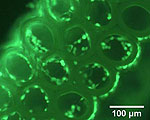Using Vitamin B2 to Print Medical Implants
 Oct-26-13
By using B2 to 3D print bio-compatible tissue scaffolds, researchers have developed a way to create non-toxic medical implants tailor-made for the patient.
Oct-26-13
By using B2 to 3D print bio-compatible tissue scaffolds, researchers have developed a way to create non-toxic medical implants tailor-made for the patient.The current method of printing complex tissue scaffolds features two-photon polymerization, during which a block of precursor liquid is selectively solidified by a targeted light source. However, the toxicity level of the photosensitive chemicals used to make the liquid causes them to be unsuitable for medical applications.
As an alternative, a team at North Carolina University developed a technique that uses the naturally light-sensitive, and bio-compatible, riboflavin (B2) instead of toxic chemicals to create the precursor liquid. According to Dr. Roger Narayan, “This opens the door to a much wider range of biocompatible implant materials, which can be used to develop customized implant designs using 3-D printing technology.”
More Info about this Invention:
[MEDGADGET.COM][NORTH CAROLINA UNIVERSITY]
Add Comment
Great idea. Would like to know more about your product.
Regards
Posted by Fernando Neves on November 1, 2013
fields are required.
Comments
Great idea. Would like to know more about your product.
Regards
Posted by Fernando Neves on November 1, 2013
Add your Comment:
[LOGIN FIRST] if you're already a member.fields are required.

Show 1 Comment